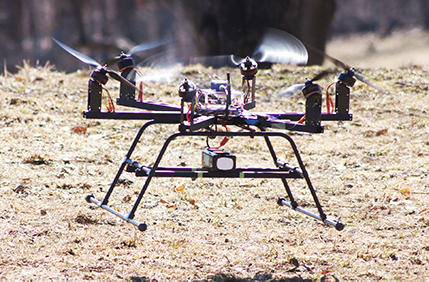In our laboratory, we are researching from the viewpoint of control engineering and robotics to overcome these weaknesses that hinder the implementation of drones in society.
In our research on “6-Degree-of-Freedom Independently Controllable Non-Plane Drones,” we developed a non-planar drone with six rotors each tilted to achieve exceptional mobility that is not possible with conventional drones. Applying the appropriate control system to this aircraft allows for the independent control of translation and rotation, and also a high level of precision in flight that far surpasses conventional drones. This research is being carried out in collaboration with a company and will be used for inspection of large-scale structures that require precision flight under strong wind turbulence. It is also possible to develop this research to establish a design theory for drones with outstanding agility suitable for individual missions.

Therefore, multiple drones equipped with sensors, including visible light cameras, infrared cameras, and ultrasonic sensors, can fly in a coordinated manner in narrow spaces to achieve efficient inspections. Furthermore, we have succeeded in realizing a flight control system that can avoids collisions, which is a problem in cooperative flight in narrow spaces, by applying “model predictive control,” a type of real-time optimal control.
Through the research mentioned above, we aim to make drones more robust for various environments and missions and further promote drones’ social implementations. Ultimately, we hope that proceeding our research can let drones to bring significant benefits to human society, and at the same time, to protect and help us in times of emergency.
Profile
Satoshi Suzuki
Graduated from Chiba University's Graduate School of Natural Science and Technology in 2008. Ph.D. Assistant Professor at Shinshu University since 2009, Associate Professor there since 2014, and current position since April 2019. He specializes in control engineering and robotics with a focus on small unmanned aerial vehicles.


